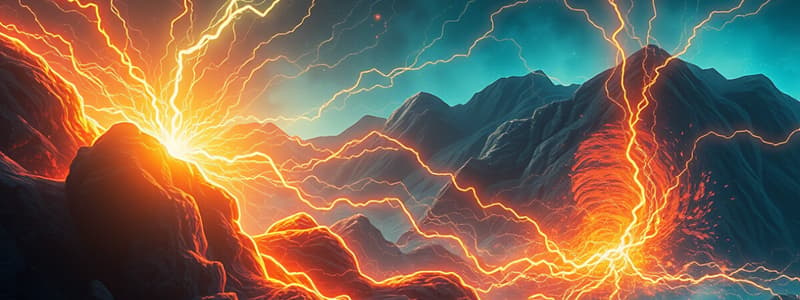Podcast
Questions and Answers
What is the process of heat transfer where particles vibrate and collide to pass energy?
What is the process of heat transfer where particles vibrate and collide to pass energy?
- Insulation
- Conduction (correct)
- Convection
- Radiation
Which type of heat transfer occurs when you feel warm air as you walk into a school disco held in a hall?
Which type of heat transfer occurs when you feel warm air as you walk into a school disco held in a hall?
- Insulation
- Convection (correct)
- Conduction
- Radiation
Which statement about insulators is accurate?
Which statement about insulators is accurate?
- Insulators enhance heat transfer.
- Insulators restrict the transfer of heat. (correct)
- Insulators facilitate electromagnetic wave transmission.
- Insulators have low thermal resistance.
What occurring phenomenon can happen when static electricity is present?
What occurring phenomenon can happen when static electricity is present?
Which of the following is a typical characteristic of convection?
Which of the following is a typical characteristic of convection?
What is the main transfer method for heat from the sun to the Earth?
What is the main transfer method for heat from the sun to the Earth?
When boiling water in an electric kettle, which type of heat transfer is primarily involved?
When boiling water in an electric kettle, which type of heat transfer is primarily involved?
Which material is known to be a good insulator?
Which material is known to be a good insulator?
Flashcards are hidden until you start studying
Study Notes
Heat Transfer Concepts
- Heat transfer occurs from hot to cold, contradicting the notion that it can occur from cold to hot (False).
- Conduction involves heat transfer through particle collisions in a medium (True).
- Steam rises because it is less dense than the surrounding air (True).
- Static electricity is not the flow of electric charge; it refers to accumulated charge (False).
- Current refers to the flow of electrons in a circuit (True).
- Radiation is a type of thermal transfer, but it does not require particles to travel through space (False).
Types of Heat Transfer Examples
- Conduction occurs when walking on hot sand, causing feet to become warm.
- Radiation heats your back when sitting in sunlight.
- Convection heats water in an electric kettle.
- Conduction occurs when feeling cold upon diving into a swimming pool.
- Convection heats the air in a school disco.
Processes of Heat Transfer
- Conduction: Heat is transferred by vibrating particles colliding and passing energy.
- Convection: Hotter particles rise while cooler particles sink, creating a circulation pattern.
- Radiation: Heat transfer occurs through electromagnetic waves without particles.
Material Properties
- A conductor is a material that facilitates the transfer of heat and electricity.
- An insulator is a material that resists the transfer of heat and electricity.
Insulation Experiment
- Data collected on temperature changes indicate foam is a better insulator than cotton wool.
- A recommended use for a good insulator is insulating a house or building walls.
Electricity Fundamentals
- Circuit components include cells, batteries, light bulbs, and resistors.
- Electrical terms associated with circuits include:
- Static electricity: generated by charge buildup.
- Circuit: a closed path through which electricity flows.
- Current: the flow of electrical charge in a circuit.
- Electrons: negatively charged particles in an atom.
- Protons: positively charged particles in an atom.
Circuit Analysis
- Evaluate circuit diagrams to determine the functionality of different components.
- Identify which bulbs will be lit if a switch in the circuit is open, noting that more than one answer may be applicable.
Studying That Suits You
Use AI to generate personalized quizzes and flashcards to suit your learning preferences.





